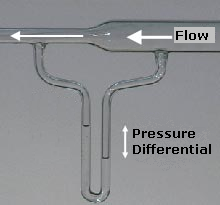
Back Bernoulli-beginsel Afrikaans مبدأ برنولي Arabic Principiu de Bernoulli AST Bernulli qanunu Azerbaijani Ураўненне Бернулі Byelorussian Уравнение на Бернули Bulgarian বার্নুলি'র নীতি Bengali/Bangla Bernoullijeva jednačina BS Principi de Bernoulli Catalan Бернуллин закон CE

| Part of a series on |
| Continuum mechanics |
|---|
Bernoulli's principle is a key concept in fluid dynamics that relates pressure, density, speed and height. Bernoulli's principle states that an increase in the speed of a parcel of fluid occurs simultaneously with a decrease in either the pressure or the height above a datum.[1]: Ch.3 [2]: 156–164, § 3.5 The principle is named after the Swiss mathematician and physicist Daniel Bernoulli, who published it in his book Hydrodynamica in 1738.[3] Although Bernoulli deduced that pressure decreases when the flow speed increases, it was Leonhard Euler in 1752 who derived Bernoulli's equation in its usual form.[4][5]
Bernoulli's principle can be derived from the principle of conservation of energy. This states that, in a steady flow, the sum of all forms of energy in a fluid is the same at all points that are free of viscous forces. This requires that the sum of kinetic energy, potential energy and internal energy remains constant.[2]: § 3.5 Thus an increase in the speed of the fluid—implying an increase in its kinetic energy—occurs with a simultaneous decrease in (the sum of) its potential energy (including the static pressure) and internal energy. If the fluid is flowing out of a reservoir, the sum of all forms of energy is the same because in a reservoir the energy per unit volume (the sum of pressure and gravitational potential ρ g h) is the same everywhere.[6]: Example 3.5 and p.116
Bernoulli's principle can also be derived directly from Isaac Newton's second Law of Motion. If a small volume of fluid is flowing horizontally from a region of high pressure to a region of low pressure, then there is more pressure behind than in front. This gives a net force on the volume, accelerating it along the streamline.[a][b][c]
Fluid particles are subject only to pressure and their own weight. If a fluid is flowing horizontally and along a section of a streamline, where the speed increases it can only be because the fluid on that section has moved from a region of higher pressure to a region of lower pressure; and if its speed decreases, it can only be because it has moved from a region of lower pressure to a region of higher pressure. Consequently, within a fluid flowing horizontally, the highest speed occurs where the pressure is lowest, and the lowest speed occurs where the pressure is highest.[10]
Bernoulli's principle is only applicable for isentropic flows: when the effects of irreversible processes (like turbulence) and non-adiabatic processes (e.g. thermal radiation) are small and can be neglected. However, the principle can be applied to various types of flow within these bounds, resulting in various forms of Bernoulli's equation. The simple form of Bernoulli's equation is valid for incompressible flows (e.g. most liquid flows and gases moving at low Mach number). More advanced forms may be applied to compressible flows at higher Mach numbers.
- ^ Clancy, L.J. (1975). Aerodynamics. Wiley. ISBN 978-0-470-15837-1.
- ^ a b Batchelor, G.K. (2000). An Introduction to Fluid Dynamics. Cambridge: Cambridge University Press. ISBN 978-0-521-66396-0.
- ^ "Hydrodynamica". Britannica Online Encyclopedia. Retrieved 2008-10-30.
- ^ Anderson, J.D. (2016), "Some reflections on the history of fluid dynamics", in Johnson, R.W. (ed.), Handbook of fluid dynamics (2nd ed.), CRC Press, ISBN 9781439849576
- ^ Darrigol, O.; Frisch, U. (2008), "From Newton's mechanics to Euler's equations", Physica D: Nonlinear Phenomena, 237 (14–17): 1855–1869, Bibcode:2008PhyD..237.1855D, doi:10.1016/j.physd.2007.08.003
- ^ Streeter, Victor Lyle (1966). Fluid mechanics. New York: McGraw-Hill.
- ^ Babinsky, Holger (November 2003), "How do wings work?", Physics Education, 38 (6): 497–503, Bibcode:2003PhyEd..38..497B, doi:10.1088/0031-9120/38/6/001, S2CID 1657792
- ^ "Weltner, Klaus; Ingelman-Sundberg, Martin, Misinterpretations of Bernoulli's Law, archived from the original on April 29, 2009
- ^ Denker, John S. (2005). "3 Airfoils and Airflow". See How It Flies. Retrieved 2018-07-27.
- ^ Resnick, R.; Halliday, D. (1960). Physics. John Wiley & Sons. section 18–4.
Cite error: There are <ref group=lower-alpha> tags or {{efn}} templates on this page, but the references will not show without a {{reflist|group=lower-alpha}} template or {{notelist}} template (see the help page).
